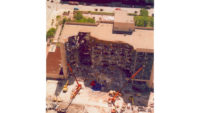In a long-awaited, historic step toward “real" not cookbook wind engineering, the Structural Engineering Institute of the American Society of Civil Engineers recently issued a recommended alternative to the building code’s prescriptive procedures for the wind design of buildings. Properly implemented, the Prestandard for Performance-Based Wind Design, available free of charge for all structural engineers to use, results in buildings capable of achieving wind performance objectives specified in the ASCE 7 design load standard, and in many cases, superior performance, according to SEI.
“This is significant,” says Don Scott, a senior principal with PCS Structural Solutions and chair of the wind loads subcommittee for ASCE 7’s standard, Minimum Design Loads and Associated Criteria for Buildings and Other Structures. “It allows us to use the reserve capacity in structures,” adds Scott, also the principal investigator for the research project that developed the 127-page prestandard, catalyzed by a $150,000 grant from the Charles Pankow Foundation.
Innovation
The document, which mandates peer review for all structures engineered using PB methods, will allow greater scope for innovation in structural and building envelope design for wind, say the members of the document’s reliability peer review team, which reviewed reliability research done by Seymour Spence at the University of Michigan. It also will result in more efficient use of building materials, while still meeting accepted levels of safety and functionality.
Scott says members of the ASCE 7 wind loads subcommittee have been talking about PBWD for many years. It took the Pankow foundation, which committed half the funds and raised the other half from the American Concrete Institute Foundation, the American Institute of Steel Construction, the ASCE Leadership Council and the MKA Foundation, to turn talk into action. The U.S. Federal Emergency Management Agency provided additional financial or in-kind support.
“Without Pankow foundation funding, we would not have been able to produce the document,” says Scott.
The prestandard was created by a committee of 13 professionals in practice, research, wind tunnel testing, education and government. It was peer reviewed by both the reliability team and a general peer review team. It outlines major design innovations, including nonlinear dynamic analysis for wind design, limited inelasticity in specified elements of the main wind force-resisting system, system-based performance criteria and enhanced design criteria for the building envelope.
Resolve Conflicts
The document also addresses a need, identified by designers, for a methodology to use when buildings are subjected to both wind and seismic events. “The prestandard has been developed to help resolve conflicts in performance objectives that exist when using prescriptive procedures for the wind design and performance-based procedures for the seismic design of individual buildings,” says the executive summary.
To develop the PBWD prestandard, Scott and his team followed the template for the ASCE/SEI PB seismic design standard, which is widely used. “We relied a lot on research in seismic design to create the prestandard,” says Scott.
Peter Irwin, senior technical director and past president of wind engineer, RWDI, and a member of the prestandard’s reliability peer review team, says, “I support PBD for wind, having participated in its application in the case of an older building that was being reevaluated against the current prescriptive code.”
The older building could not meet the simple prescriptive criteria of modern wind codes, which require the structure to remain in the elastic range up to the ultimate design wind speed, says Irwin. It would have had to be demolished, adds Irwin, who also is a voting member of the ASCE/SEI wind committee, since the early 2000s.
But PBWD allowed analysis of the historic structure beyond the elastic range, as in seismic design, and showed the main structure had plenty of reserve of structural strength and did not need to be demolished, Irwin says.
The PBWD document introduces design innovations that require additional studies to build a body of knowledge related to its application and to support its acceptance and approval as an ASCE/SEI standard. Consequently, the prestandard takes a conservative approach to design, says Scott.
To date there have been only 15 or 20 structures designed for wind using the required nonlinear time-history analysis. There need to be hundreds to fully determine the reliability of the methodology, adds Scott.
Standard
It could take three years to collect the data required for a full standard and another three to develop the standard, which is expected by about 2025. SEI is preparing a white paper to discuss the research needs to develop a full standard.
Meanwhile, to familiarize engineers with the methodology, Scott will present a session on advances in PB wind engineering at the annual ASCE/SEI Structures Congress, next April 5-8, in St. Louis. There will also be articles in Structure Magazine.
In addition, the ASCE 7-22 wind loads subcommittee will be developing and balloting proposals to reference the prestandard into the commentary of the 2022 edition of ASCE 7. "ASCE rules preclude direct reference of a prestandard in the code body, but not unlike the origins of seismic PBD, we can reference this prestandard in the ASCE commentary," says Russell Larsen, a senior associate with structural engineer Magnusson Klemencic Associates and one of the writers of the new document. "Doing so gives a go-to source for designers," he adds.




Post a comment to this article
Report Abusive Comment